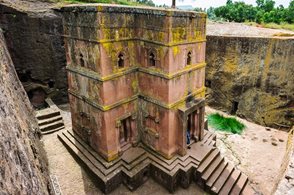
Ethiopia is home to one of the oldest Christian communities in the world. Converted by Philip the Evangelist in the 4th century A.D., today two-thirds of the country’s population belongs to the Ethiopian Orthodox Church, a branch of Egypt’s Coptic Church, which was granted autonomy from the Patriarch of Alexandria in 1959, and is a major center for the Orthodox faith in Africa.
In the 12th Century, devout King Lalibela went to Jerusalem where he had a vision of Jesus Christ, who ordered him to build a church from a single block of stone. Unlike Saint Peter, who interpreted the idea of building a church on a rock as a metaphor, King Lalibela took the words of Christ literally. Returning home to Ethiopia, he ordered the construction of a complex of monolithic churches carved in the tough pink volcanic rock of the north of the county. The resulting eleven churches, which the faithful believe could have only been executed with the help of angels, are remarkable architectural and religious achievements and a major UNESCO world heritage site.
Monolithic churches were known throughout the world from ancient times, particularly during the period of persecution of the new Christian sect, when worshipers often met in secret, remote, and inaccessible venues. Many churches were carved into the walls of caves, but Lalibela pushed this concept to its zenith. Possibly the only structure to be built from the top down, the churches of Lalibela were chiseled into the rocks by master masons with flawless geometric precision. Further engineering prowess is found in the complex system of tunnels, which provide the only passage between the churches as well as sophisticated drainage.
For Ethiopian Orthodox Christians, visiting Lalibela is religious obligation: everyone must make the pilgrimage (the most devout go barefoot) to the churches at least once in their lives and the pilgrimage to Lalibela is considered on a par with that to Jerusalem. Between 80,000 and 100,000 Orthodox Christians make the journey annually, numbers that are beginning to swell as Ethiopia gains in popularity as an emerging travel destination.
Lalibela is often compared in scale and scope to the stunning architectural achievement of Jordan’s Petra, but unlike Petra which was abandoned the churches of Lalibela are still busy functioning houses of worship, offering daily services for the local population and the pilgrims who swell their ranks.
Alexander+Roberts are delighted to feature the full range of Ethiopia’s ethnic traditions including an exploration of Lalibela with our latest
Adventures in Ethiopia.